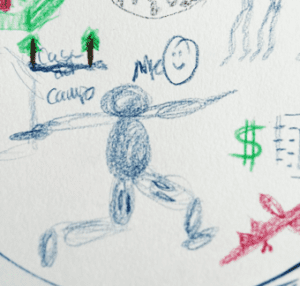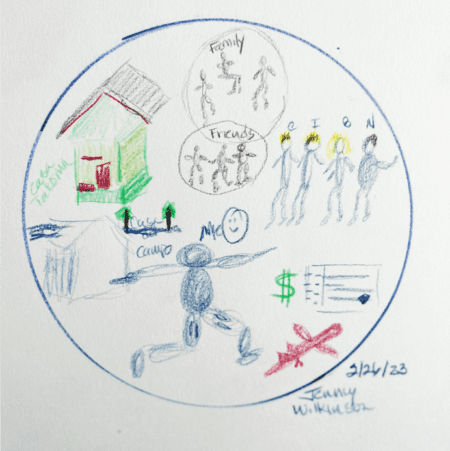What Art Communicates
We have recently been running a workshops series on what our art communicates.
People Are Sheepish About Showing Their Artwork
Invariably, when people are invited to share what the art they made, almost everyone hesitates. They worry that their artwork is either too childish, too primitive, not good enough, different from what everyone else made, or just plain old wrong.
This happens to practically everyone—from the non-artists, to the “amateurs”, to the “real” artists.
What we can learn from this universal response is first two things:
1) That the Inner Critic emerges when we are called to display something about ourselves that we fear will be judged and
2) It brings up abounding misconceptions about what art is and who is an “artist”
But perhaps even more important by our estimation, it obscures the TRANSFORMATIONAL (Ok we’re just a little bit passionate about this) capacity of art to reveal more about ourselves… to ourselves.
It Reveals More Than Our Level of Artistic Skill
And when we say “reveal” we are not talking about exposing our primitive drawing skills or any other flaws. The “artists” are also critically judging what they’ve made even as everyone else might be “ooohing” and “aaahing” over the aesthetic virtues of their piece. Realistically, at first blush both are likely true—the amateurs’ artwork is probably more primitive and childlike and the artists’ imagery is likely more aesthetically “successful”.
It’s Artistic Merit Is Important But It Isn’t the Point
However, despite the discomfort of experiencing this dynamic, that is not the point. It doesn’t mean it isn’t relevant (that is the topic of other newsletters), just that from the vantage point of art as an opportunity for self-knowledge and growth, it is only part of what matters when we make artwork.
We Are Accessing More Of Minds
What matters more is that we are accessing information from our minds that, no matter how rudimentary the image is, we do not access through other means. That is communicated through the metaphors inherent in the visual properties of the artwork and the way the artwork is made.
Jenny’s Example: A Simple Diagram
We’ll give you a couple of examples starting with Rebecca’s sister Jenny’s art from one of the Art for Self-Discovery workshops (the at the top of this post). In contrast to many of the images that other people had made in the workshop that were colorful and “artistic”, she had taken the instruction to “Make a circle on paper and then add to the drawing symbols for the things that are important to you or impact your life” more literally and had drawn a diagram of what was significant in her life.

Jenny has attended many of Rebecca’s workshops so she knew that there was probably more significance to what she’d drawn, however simple it was. So it was no surprise when it was pointed out that the image of herself exercising was at the base of the image, which she then recognized was probably because it is so foundational to her wellbeing.
Information in the Relationship Between Different Elements of the Image
On the other hand, when she noticed that that figure had no face, but there was a simple smiley face floating next to it at the center of the mandala, she realized that there was a disconnection between her focus on her body and her core sense of self, something that she decided she needed to focus on.

Annu’s “Pure” Heart
Annu, an old friend who has also been coming to the workshops had what we might call a more aesthetically “artistic” piece. In response to the same instruction as above, Annu first drew a large circle but then decided that she wanted to add an even larger heart. When we explored her image, she was surprised that, even though it was a much simpler and less detailed image than Jenny’s in many ways, and she felt like the heart was a bit cliché, it was still full of unexpected meaning.
When Annu first made the image, she had intended the marks all around the periphery of the heart and circle to represent all of the noise and negativity both internal and external that were underneath the purity of white light in the heart. When we noted that those marks were actually clearly outside of the heart, even though in her mind’s eye she saw the negativity as being behind and overlaid by “spirit”. When she described and voiced what was literally in the image, the message became clear to her.
Metaphors Are Usually Concrete and Literal
Although the metaphor is so concrete that it is almost comical, it was not lost on Annu—that this negativity that she perceived to be behind and underneath her spirit was actually literally outside of it. None of the marks that represent the negativity enter into the “pure” inner domain of the heart.
These are just a couple of simple examples of the way that art presents a concrete metaphor for what is happening in our internal world which we could not necessarily access through words.
Come experience this phenomenon yourself in the next Art for Self Discovery workshop. Click here to find out when the next one is being help and for instructions on how to attend.
